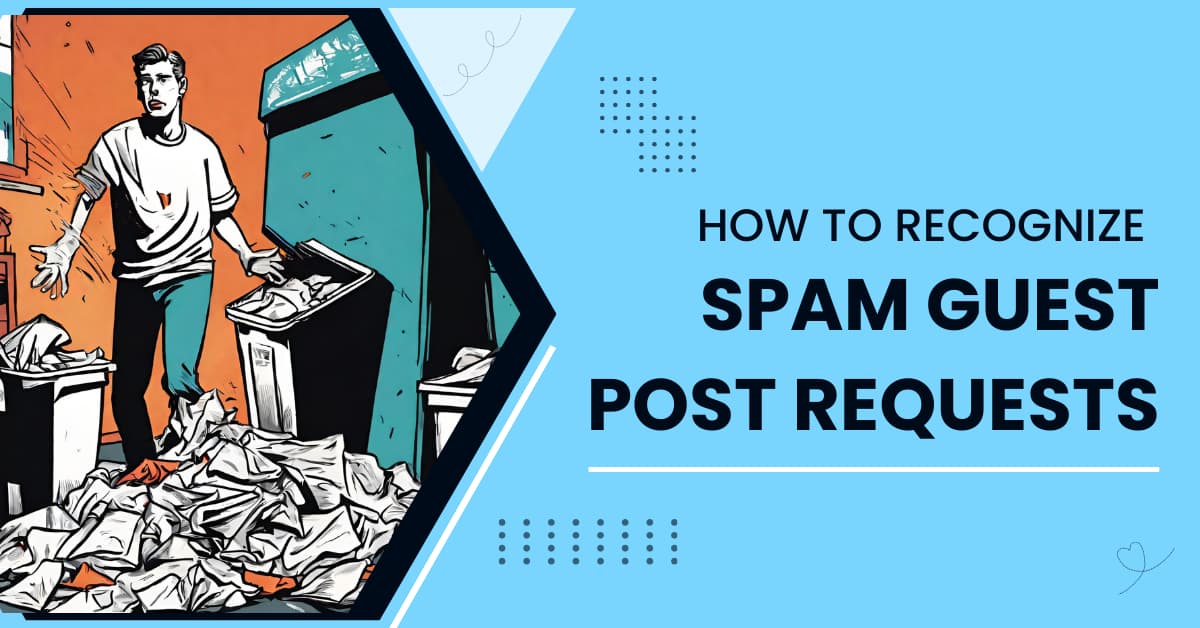Fed up with going through endless spam guest post requests cluttering your inbox?
It’s time to tackle this problem head-on.
I’m here to give you the straightforward plans to tell the good requests from the bad ones.
Get ready to learn how to identify those spammy pitches and protect your blog’s trustworthiness, all without too much effort.
Let’s jump into clearing out the clutter and keeping your content quality top-notch.
Unveiling the Veil of Spam Guest Post Requests
Like modern versions of the Greek myth, an endless flood of guest post requests fill inboxes daily.
But instead of poisonous snakes, empty opportunities pretending to be collaborative openings clutter the area.
Without inspection, your site’s honesty and limited resources risk being used by shallow promises focused only on self-interest rather than mutual value.
Yet careful checking shows consistent signs telling apart real opportunities from spam.
Understanding the Anatomy of a Spam Guest Post Request
The patterned nature of spam guest post requests makes spotting them straightforward once you know the common traits.
Length is illustrative, with overly short emails leaving out specifics or relevance common.
Content focuses only on the sender’s personal goal instead of reader interests or value offered.
Huge yet unsupported claims about deliverable traffic, backlinks, or search ranking boosts also describe spam promises.
Super-high guarantees without context or examples raise suspicion. Likewise, sloppy writing full of grammatical errors and misused terms shows little effort or investment.
Plagiarized materials copied word-for-word from existing sites bring potential legal issues.
Money demands represent another part of spam offers. Requests for upfront payments, revenue splits after publication, or demands for dofollow affiliate links in exchange for posts show motives focused more on exploitation than teamwork.
The Red Flags: What to Watch Out For
When reviewing guest post chances, many red flags should cause more inspection.
Too much flattery and name dropping of well-known brands try to lower defenses.
Made-up urgency including strict deadlines and pressure for instant choices also tries to avoid better thinking.
Even aggressive legal threats describe common, if questionable, tricks trying to force agreement.
Contact information deserves checking too.
Unknown free email accounts traced back to questionable domains raise credibility questions.
Research all links thoroughly, as affiliate networks spreading malware or spam could hide one click away.
Mass blasts of copied content to wide bunches of sites signal another warning sign.
Lack of personalization or meaningful relevance to your niche shows no real effort understanding your brand.
Lazy reliance on template form letters focused only on the sender’s goals brands the approach as clearly spammy.
By staying alert to these and other red flags, you gain power to filter out self-focused requests poorly acting as teamwork chances.
Without proper checking, allowing spam to enter site boundaries risks unintended consequences.
Though guarding gates needs constant watchfulness, far greater dangers await sites failing to protect honesty against relentless spam attacks.
Staying alert to red flags grants power in filtering spam pretending to be chance. But without careful guarding of boundaries, far greater dangers brought by spam may destroy site honesty.
Now more than ever, swift spotting before entering proves key to handling relentless attacks on the gates.
The Impact of Spam Guest Posts on Your Blog
Like seeing a few weeds sprouting through cracks in a pristine garden path, the start of spam guest posts often seems harmless at first glance – perhaps even positive.
A quick content addition here, a boost in backlinks there from low-effort partnerships. But left unchecked, the invasion of spam rapidly chokes out the liveliness keeping growth until permanent damage transforms beautiful landscapes into dry wastelands.
Make no mistake – spam posts bring ruin, not bounty.
The fragmented content experiences and jarring tone shifts common in spam posts confuse loyal readers who expect expertise and relevance from trusted sites.
Audiences feel let down when spam content fails to deliver value, harming site identity simply to advance outside goals.
Declining engagement, subscriptions cancellations, negative comments all signal the loss of reader rapport once the lifeblood of blogs.
Equally damaging, low-quality spam posts weaken overall content quality, signaling a shift from core competency to search engines judging authority.
By basically “watering down” expertise density, spam posts reduce keyword visibility over time.
Recovery requires reestablishing topical relevance through high-quality content matched to audience needs – no small feat once traffic momentum slows.
But equally significantly, the parasites hitched inside spam posts wreak havoc once allowed inside.
The thin guest content merely hides black hat SEO tactics like keyword stuffing, hidden links and questionable backlink networks.
Such clear violations of search guidelines severely risk manual penalties, including possible site blacklisting.
Removing toxic links and safeguarding platform integrity from repeat infiltrations consumes immense resources better used toward audience development.
In allowing spam to enter boundaries, bloggers enable the parasites destroying site health.
But the impacts appear slowly at first, making early intervention critical before cascading damages overwhelm and replace growth.
Staying watchful against infiltration protects the vibrant lands sustaining your community.
Neglecting gates allows weeds dominating the garden and choking out life bit by bit.
SEO and Reputation Risks
Behind the illusion of effortless traffic bounty, spam posts introduce Trojan horse style threats ready to erode site strength once given a spot.
The low-quality content rides upon the host site’s hard-won authority to briefly rank well, but lacks the uniqueness or expertise search engines evaluate when giving visibility.
By effectively weakening overall content quality, spam posts signal a shift from core competency over time that lowers keyword visibility.
Readers also notice the declining expertise from disjointed spam content made only to rank, not inform. Their disengagement further speeds declines by eroding the site’s credibility as an authority worth trusting.
But equally damaging, the parasites smuggled within spam content bring lasting infections that prove challenging to cure.
The thin guest posts hide black hat SEO tactics like keyword stuffing, hidden links and questionable backlink networks violating search guidelines.
The resulting penalties from manual reviews by Google include possible site blacklisting, requiring extensive removing of toxic links and safeguarding gates to prevent repeat infiltrations – easier said than done once integrity is lost!
In essence, rather than quick rewards, spam posts spread toxicity destroying site health.
But early detection and selective posting prevents irreversible contagion before it conquers territory.
The impacts reveal why barricading gates using watchful filtering separates longevity from fleeting visibility spikes gone as swiftly as they appear.
Operational Bottlenecks and Resource Wastage
In permitting spam proposals entry based on profitability alone absent context, bloggers enable the displacement of resources from content production matched to audience needs.
Hours consumed vetting and editing irrelevant spam posts represent lost opportunities better spent developing strategies centered on community development.
Instead, contributor relationships suffer from mismatch between guest agendas versus what enriches reader lives.
Declining engagement and subscriptions signal the loss of rapport once the beating heart of growth.
Equally draining, the fragmented experiences from spam posts buried between authentic content leaves readers struggling to connect interests between posts.
Site cohesion feels lost when promotional agendas override informational intents. The opportunity costs mean less enriching content reaches audiences while customer confusion burdens expand.
Overwhelmed bloggers become less receptive toward collaboration opportunities more aligned to mutual growth.
By failing to filter out spam proposals offering quick returns through cheap content and easy backlinks, bloggers degrade sacred reader relationships built on trust.
In chasing short-lived visibility spikes, the lasting ties sustaining progress across seasons risk being severed.
Anchoring site direction on community alignment protects the resources carrying messages over time. Just as staying centered on enriching lives shields against deterioration, proactive evaluation of posting opportunities safeguards against infiltration of agendas mismatched with growth.
As we’ll explore next, upholding integrity through spam detection grants the sight to recognize what nourishes over what briefly glitters.
Best Practices in Spam Detection and Verification
Like waves that never stop crashing on lighthouses built along shores to protect passing ships, floods of shallow guest posts constantly hit site owners every day with promises of quick rewards if allowed in. But instead of chasing every wave, smart captains anchor integrity by making layered defenses that check each case to see if it matches what they want.
Advanced tools do the first check, filtering out clear lies early using CAPTCHA tests and traps that catch automated bots.
Equally helpful, AI-powered filters closely watch writing patterns on a large scale to catch recycled pitches.
Header checks provide more context – inconsistent domain authority scores often show ecosystems lacking real value for readers.
But human judgment also proves critical in filtering by growth-focus, not just numbers.
Custom protocols allow case-by-case evaluation of chances on helping the community vision versus purely selfish aims.
Strict steps start by requiring initial forms detailing niche experience to filter serial guest posters from serious minds.
Further phases require sharing site metrics and content samples for structured comparisons on relevance and abilities.
Finally, test writings and ongoing monitoring let you respond quickly if quality drops over time.
While essential for checking guest posts case-by-case, customized vetting protocols gain their power from the site guidelines they serve to enforce.
Much like dedicated security guards protecting exclusive venues based on defined guest lists, the rigor of persistent checking means little without the codes saying what earns access versus rejection.
This shows why anchoring direction through clear boundaries that empower case-by-case evaluation separates sites maintaining integrity despite constant waves testing their gates daily.
As well explore next, crafting guest post guidelines aligned to growth goals grants the power to recognize what nourishes community over what briefly glitters with enticing promises alone.
Crafting Clear and Effective Guest Post Guidelines
Ah, the endless flood of guest post submissions filling the inboxes of site owners everywhere – an ocean of asks, some diamonds sparkling with potential, others simply stones sinking progress if allowed onboard.
The appeal of quick content paired with easy backlinks tempts even the most focused captains. Believe me, I’ve certainly had moments of wavering integrity, hastily approving posts to hit monthly quotas only to regret falling standards once decline started compounding.
It takes committed dedication to uphold quality criteria case-by-case rather than reactively compromising overall ecosystem health chasing each new wave of requests focused more on exploitation than mutual enrichment.
But maintaining boundaries serves a crucial purpose – anchoring site direction to audience rapport sustains the resources carrying messages over seasons.
When fragmented guest agendas override informational intents, readers rightfully disengage from confusing experiences buried between authentic content.
Before long, credibility vanishes as expertise gives way to commodity.
So whether by advanced filters or manual vigilance, proactive evaluation of what nourishes community versus what briefly shines for selfish aims proves foundational.
Setting the Boundaries: What to Include in Your Guidelines
As someone naturally inclined to see all perspectives, I wrestled with simply banning guest posts entirely to uphold standards.
But hearing pitches recounting personal stories of rising creators seeking conduits for reaching wider audiences touched my empathy.
I realized partnership could enrich both sites if rooted in transparency – but only when aligned in values.
So I established clear content guidelines requiring relevance to my niche, with examples of on-brand voice and style.
I’m upfront in banning promotional angles and overly self-referential bios.
I insist on original analysis given my legal liabilities, specify minimum word counts to encourage depth, provide imagery guidance supporting points, and set collaborative timelines for drafts and revisions.
I also mandate:
- Proper attribution
- Disclosure statements around sponsorships per FTC rules
- Enforced separation of commercial affiliate links from informational intentions
Submittable forms ensure compliance. Ongoing monitoring checks new posts regularly to validate conformance.
Enforcing Your Guest Post Policy
However, quality standards absent enforcement lack impact.
I’ve faced the hard lessons there too – briefly hiring a contractor to vet submissions who cared more about volume-driven bonuses than protecting my site’s rapport with readers.
Despite initial policy trainings, I kept needing to override approvals of posts with clearly misaligned incentives focused exclusively on driving financial traffic.
Now I personally oversee layered reviewing aligned to audience needs at each phase.
Initial screening questionnaires check niche abilities through evaluating writing samples demonstrating grasp of my sites voice.
I use plagiarism checks on drafts and enforce my formatting guidelines regarding scannable structure and readable word count minimums.
During editing, I flag then remove any embedded affiliate links or promotional references that distract readers.
If issues emerge post-publishing, I enforce warnings, edits, or full removal of posts per signed policy terms.
Protecting community trust requires demonstrating commitments to standards outweigh author relationships when violations emerge – though I aim to communicate such steps empathetically through open dialogue around intentions before taking action.
We all have moments of misjudgment that deserve grace. But unrelenting consistency evaluating contributions by what nourishes site rapport rather than what serves selfish aims remains vital to prevent descending into commodified content mills rather than resources readers rely on across seasons.
While also acknowledging the humanity behind guest posting, in my younger days, impatience at those testing my carefully erected boundaries through misaligned posts blurred my ability to respond with compassion. Believe me, reactively banning authors at the first misstep never ends well!
Over time, I’ve learned discernment allows addressing issues without attacking persons. Moving forward, well explore how to handle the flood of spam requests with understanding for personal stories while still upholding site integrity through kind communication of boundaries.
Responding to Spam Guest Post Requests with Tact and Professionalism
I’ve certainly felt the constant waves of shallow guest posts trying to take advantage of my site’s popularity only for quick wins instead of mutually benefiting readers.
But does refusing such clear mismatches between goals require attacking submitters? Or could kind consistency upholding community standards also gently guide inexperience towards collaborative growth helping all?
I believe creative peacemaking allows firmly maintaining integrity yet still seeing the shared humanity underlying the flood of asks.
The Gentle Letdown: Politely Declining Spam Proposals
Personally writing individual responses for each submission strains resources, no question. Yet even using smart bots for heavy filtering, taking time for customized care remains vital to building reader relationships.
So, what communication style maintains site alignment while still addressing destructive issues constructively, not targeting persons?
I keep quick yet tailored canned templates ready to efficiently share rejections for clearly spammy posts missing the mark.
But I intentionally adjust the tone of each response to redirect versus dismiss submitters.
I explicitly recommend reviewing the publicly posted educational guidelines, briefly and politely summarizing precise reasons the alignment lacks while extending grace over judgment.
Shouldn’t creative peacemaking seek understanding and future mutual growth opportunities?
I try to focus on protecting site integrity and serving subscriber needs rather than personally critiquing authors’ abilities or intentions.
I know first-hand how enthusiasm can outpace experience starting out!
With practice maintaining composure despite the relentless rush of asks, I’ve built discernment addressing mismatches rationally on evidence, not reactively targeting individuals.
Creating a Positive Outcome from Negative Interactions
For promising contributors showcasing authentic passion for my niche despite initial guideline mismatches, I make time to provide personalized improvement feedback. I thoughtfully summarize how future drafts could better showcase abilities and dedication through relevant analysis rather than links alone.
I also consider anonymously featuring real-life stories of off-base outreach attempts in transparency posts – detailing common pitfalls helps audiences learn alongside me! But my aim stays fixed on overcoming dysfunction by transforming interactions into springboards for mutually beneficial standards and vision.
Reflections
Dealing with spam guest post requests means staying sharp and making firm choices.
You have to identify the fakes fast-watch out for generic messages, bad writing, and off-topic ideas.
Make clear rules for guest posts and follow them strictly.
Keep your attention on quality content that helps your readers, not just on filling up space.
Tighten how you handle submissions, clearly share your standards, and remove anything that doesn’t fit.
Keep your blog trustworthy, valuable, and true to what your audience expects.
That’s how you keep your blog going strong.



